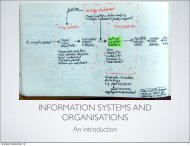Flensburg P: Personlig databehandling - Per Flensburgs hemsida
Flensburg P: Personlig databehandling - Per Flensburgs hemsida
Flensburg P: Personlig databehandling - Per Flensburgs hemsida
Create successful ePaper yourself
Turn your PDF publications into a flip-book with our unique Google optimized e-Paper software.
<strong>Per</strong> <strong>Flensburg</strong>: <strong><strong>Per</strong>sonlig</strong> <strong>databehandling</strong><br />
changes is thus very important. The capacity for changing data systems must be increased.<br />
This can be done in three ways:<br />
• By increasing the productivity of the system designers<br />
• By increasing the number of system designers<br />
• By both increasing the productivity and number of system designers.<br />
The first one is possible since we today have powerful tools for speeding up the development.<br />
We have different types of structured design that might increase productivity<br />
by 10 to 20 % (Martin 1982). We also now have application generators or 4th generation<br />
languages that will typically reduce coding time 50 to 80 % (Ibid). Even nondata<br />
experts can use these tools, after a short introduction, to develop their data systems<br />
and thus achieve the third possibility. Today there exists a variety of such tools<br />
and since they have been in use for a number of years it would be an interesting research<br />
task to investigate the effects when using such a tool. This is my main problem.<br />
When people in an organization use application generators as support in their<br />
work I call this personal data processing.<br />
7.2 Scientific approach<br />
A traditional approach to such an investigation should be the verification of a set of<br />
hypotheses. This set must however be based on an understanding of the factors that<br />
are important. You do not get answers to questions that are not asked!<br />
Important issues in <strong>Per</strong>so-<br />
nal data processing<br />
Theories of <strong>Per</strong>so-<br />
nal data processing<br />
188<br />
<strong>Per</strong>sonal data processing<br />
Case studies<br />
Action oriented<br />
research<br />
Fig 7.1 Relationships between the different parts of the research project.<br />
The factors are parts of a theory, so we thus need a theory of user developed support<br />
systems in order to undertake a traditional scientific approach.<br />
The whole research process can be described in fig 7.1, which is a modification of a<br />
similar figure in Checkland (1981, p 8). I suggest here two approaches in the study of<br />
personal data processing. The first one is based on collecting experiences from such







